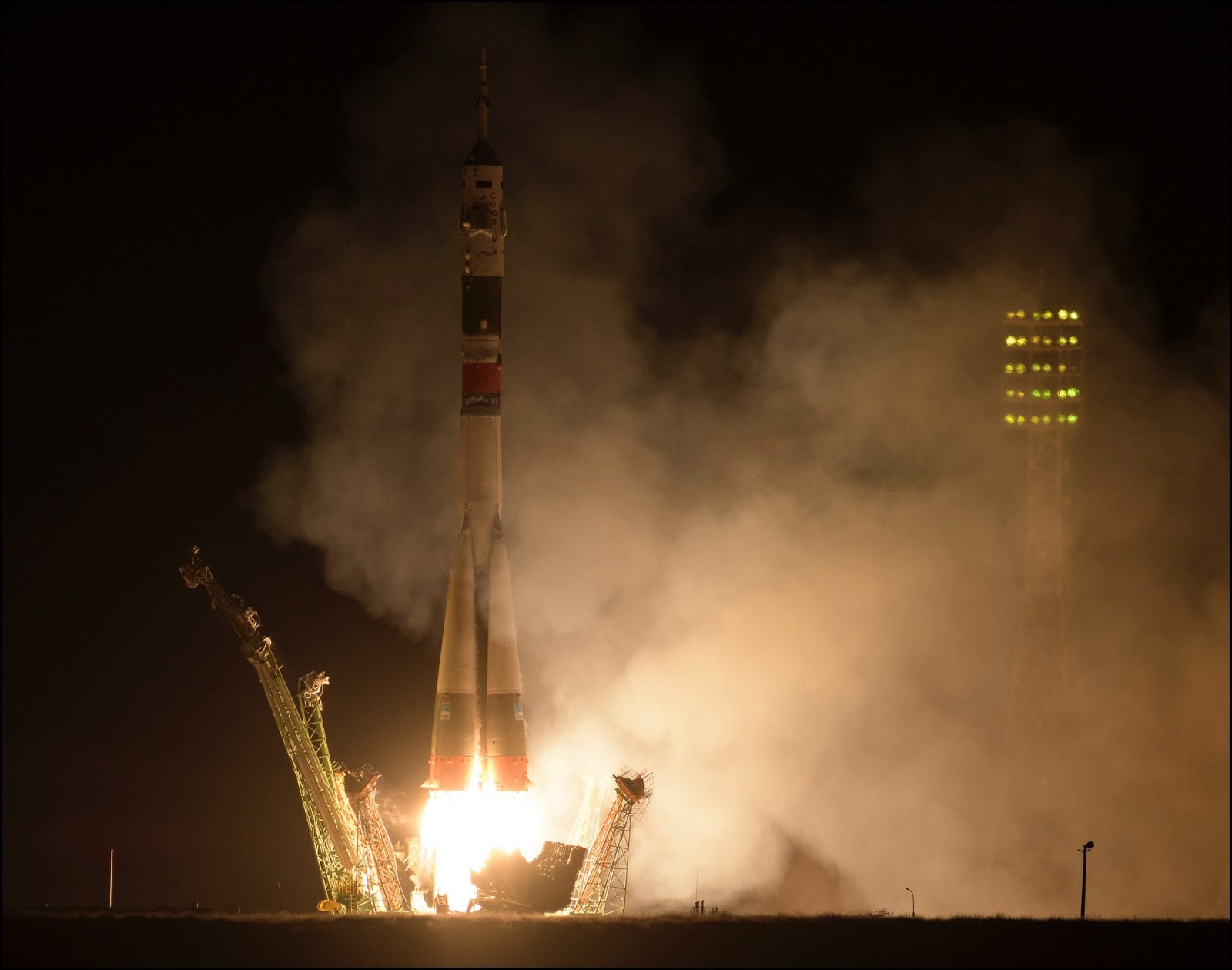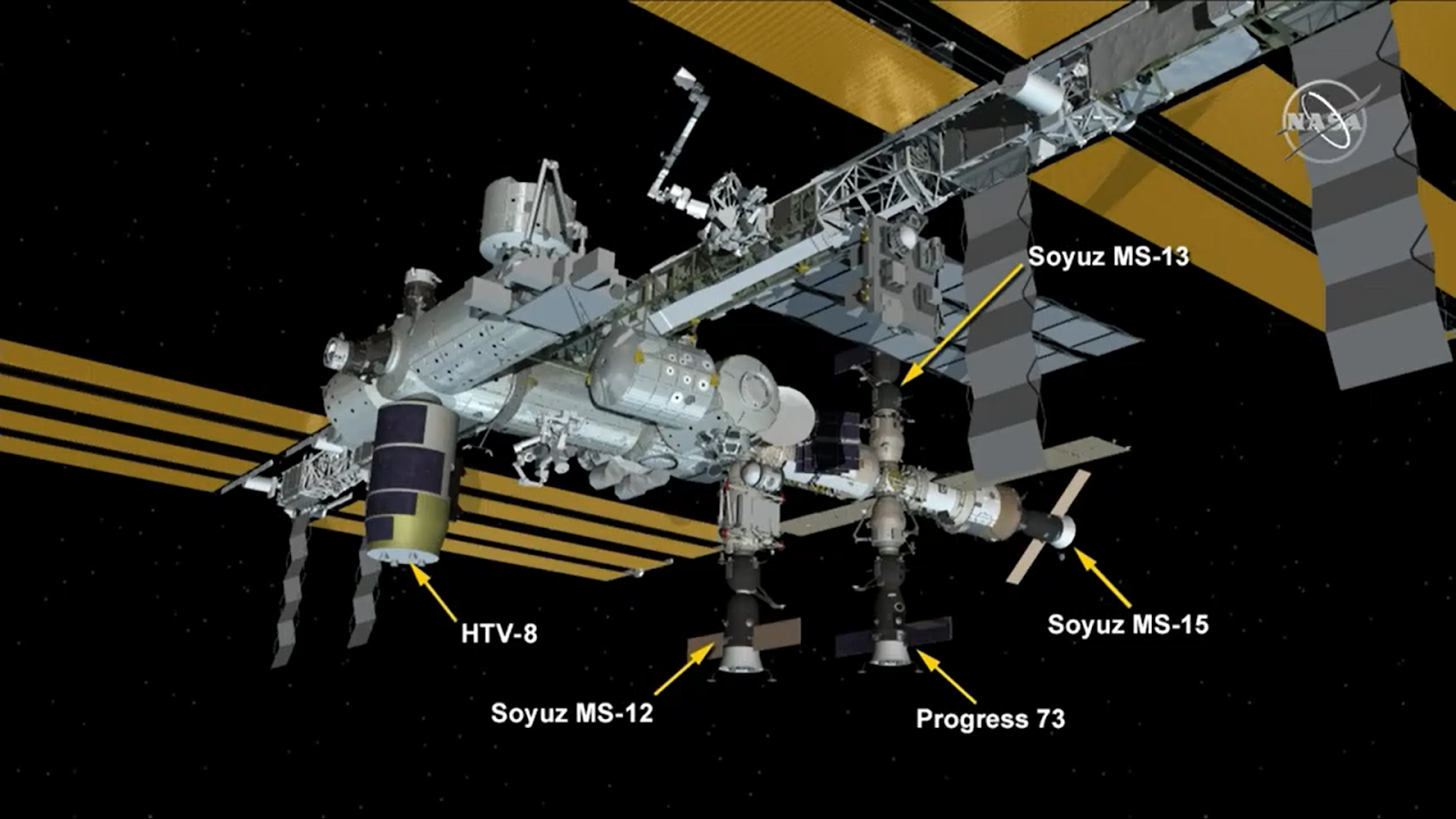
CAPE CANAVERAL, FL – Less than 24 hours apart a pair of critical crew and cargo spaceships successfully launched back to back to the International Space Station (ISS) on Tuesday and Wednesday, Sept. 24 & Sept. 25 – the Japanese HTV-8 cargo freighter from Japan and Russia’s Soyuz MS-15 crew vessel from Kazakhstan respectively, making for a hugely busy week of space action!
Thus the orbiting outpost is now temporarily home to 9 humans from 4 countries for the next week !! – living and working peacefully in space cooperatively for all humanity.
Carrying a new multinational trio of spaceflyers, the Russian Soyuz MS-15 spaceship blasted off at 9:57 a.m. EDT (6:57 p.m. Kazakhstan time) from the Baikonur Cosmodrome in Kazakhstan with NASA astronaut Jessica Meir, Oleg Skripochka of the Russian space agency Roscosmos, and the first space traveler from the United Arab Emirates (UAE), Hazzaa Ali Almansoori.

And NASA astronaut Christina Koch snapped an absolutely beyond stunning photo of the Soyuz MS-15 blastoff this morning Sept. 25 from on board tha Space Station with the second stage exhaust plume brilliantly lit up – as her best friend NASA astronaut Jessica Meir soars to orbit with her new trio for a space docking just four orbits and six hours later at the aft end of the Russian Zvezda service module.
The Roscosmos Soyuz docked at the million pound orbiting research complex at 3:42 p.m. EDT while soaring 264 miles over the south Pacific off the west coast of Chile. The entire launch and docking sequence was carried live on NASA TV.



During the welcome ceremony, the three newest station residents were greeted by the current Expedition 60 crew comprising NASA astronauts Christina Koch, Nick Hague, Andrew Morgan, ESA (European Space Agency) astronaut Luca Parmitano, cosmonaut Alexander Skvortsov (Roscosmos) and station commander Alexey Ovchinin also of Roscosmos.
This is Meir’s and Almansoori’s first spaceflight and Skripochka’s third.
The unusually high number of 9 crew on board is the most since 2015 since September 2015, when nine crew members were aboard for seven days during Scott Kelly and Mikhail Kornienko’s year-long mission.

The crew size will return to its normal of six with the departure of Soyuz MS-12 spacecraft when it returns to Earth Thursday, Oct. 3 with spaceflight participant Hazzaa Ali Almansoori along with Hague and Ovchinin, who are completing more than 200 days in space.
With their departure Expedition 61 officially begins.
Overall Almansoori is the 10th spaceflight participant – under contracts with Roscosmos – and the first since 2009.

Overall 239 people from 19 countries have now visited the International Space Station since assembly began.

Meanwhile the Japan Aerospace Exploration Agency (JAXA) H-IIB rocket launched at 12:05 p.m. EDT Tuesday, Sept. 24 (1:05 a.m. Sept. 25 in Japan) from the Tanegashima Space Center in southern Japan. At the time of launch, the space station was flying 258 statute miles over Mali in southwest Africa.
A little more than 15 minutes after launch, the unpiloted H-II Transfer Vehicle-8 (HTV-8) cargo spacecraft successfully separated from the rocket and began its four-day rendezvous with the International Space Station.
The HTV-8 cargo freighter named Kounotori from JAXA (Japan Aerospace Exploration Agency) is packed with over four tons of crew supplies, station hardware and new science experiments.
It will arrive at the station Saturday.
“NASA astronauts Christina Koch and Andrew Morgan will capture Kounotori with the Canadarm2 robotic arm around 7:15 a.m. Ground controllers will then take over and remotely install the Japanese resupply ship to the Harmony module about three hours later,” says NASA.
This is the 8th HTV resupply ship to launch to the ISS. Among the cargo are six new Lithium-ion batteries that will be swapped out for old nickel-hydrogen batteries as part of the ISS power supply system during astronaut spacewalks in October.
Japan’s H-2B rocket from prime contractor Mitsubishi Heavy Industries stands 186-feet-tall (56.6-meters).
“The Expedition 61 crew will spend more than six months conducting about 250 science investigations in fields such as biology, Earth science, human research, physical sciences, and technology development. Work on the unique microgravity laboratory advances scientific knowledge and demonstrates new technologies, making research breakthroughs that will enable long-duration human and robotic exploration of the Moon and Mars,” says NASA.
“During Expedition 61, crew members will install new lithium-ion batteries for two of the station’s solar array power channels through a series of spacewalks. Later in the expedition, spacewalkers are scheduled to upgrade and repair the Alpha Magnetic Spectrometer, a key science instrument housed outside the station to study dark matter and the origins of the universe.”




Great articl1e! Your posts are so interesting and I learn a lot from them.
Thx Jean Wright for nice comment above